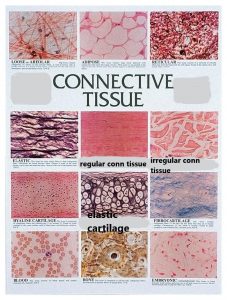CONNECTIVE TISSUES AND MCQs for NEET, GPAT, Pharmacist, UGC NET JRF Exams
Tissues are broadly classified in four types-
- epithelium
- connective tissue
- smooth muscle tissue
- nervous tissue
In this article we are going to study about connective tissues.
Connective tissue consist of two basic elements, the extracellular matrix and the cells. the tissue’s extracellular matrix is the material present between the spaces between the cells. the matrix consist of proteins, fibers and ground substances. the matrix vary from tissue to tissue, like cartilage’s extracellular matrix is firm but pliable and that of bone tissue has matrix hard and inflexible.
Connective tissue cells are of five types-
- fibroblasts
- adipocytes
- mast cells
- white blood cells
- macrophages
classification of connective tissue is based on the differences in the cells and the extracellular matrix, they are classified as-
- loose connective tissue
- dense connective tissue
- cartilage
- bone tissue
- liquid connective tissue
Loose connective tissue
- areolar tissue:- consist of collagen and elastic fibers and cells like fibroblasts, macrophages, adipocytes etc present in the semifluid ground substance, they are present in hypodermis, papillary region of dermis and body organs. Functions are they provide strength, elasticity and support
- Adipose tissue:- it mainly contains adipocytes cells which stores triglycerides., present around the heart and kidney , in yellow bone marrow etc, they reduce heat lose from the skin, works as energy reservoir and many more
- Reticular tissue:- consist of network of interlacing reticular fibers and reticular cells. Found in stroma of liver, spleen, lymph nodes, around blood vessels. functions include- forms stroma and binds together.
Dense connective tissue
- Dense regular tissue:- consist of collagen fibers regularly arranged in bundle and the matrix present is shiny white and fibroblasts are also present. Forms tendons, ligaments and aponeuroses. It provides strong attachment between different structures.
- Dense irregular tissue:- consist of collagen fibers which are randomly arranged and also contains few fibroblasts. Found in reticular region of dermis, pericardium of heart etc. This tissue provides strength.
- Elastic tissue:- consist of elastic fibers and fibroblasts present between them. Present in lung tissue, trachea, bronchiole tubes etc and it allows stretching of various organs
Cartilage
- Hyaline cartilage:- consist of bluish-white shiny matrix, found in trachea, bronchi, bronchiole tube etc, provides smooth surface for movement between joints.
- Fibrocartilage:- consist of thick bundles of collagen fibers within extracellular matrix, present in pubic symphysis, intervertebral discs and parts of tendons etc. it provides support and fusion.
- Elastic cartilage:- consist of thread like structures of elastic fibers, found in larynx, external ear and auditory tubes and gives supports and maintains shape.
Liquid connective tissue
- Blood:- consist of blood plasma and formed elements like RBCs, WBCs and platelets. present within blood vessels and chambers of heart. Functions includes RBC transport oxygen and carbon dioxide, WBC carry on phagocytosis while platelets are essential for blood clotting.

Multiple choice questions(MCQs)
1. What is the major function of fibroblasts?
A. secrets fibers B. stores triglycerides
C. produce histamine D. both A and C
2. What type of extracellular matrix is found in cartilages?
A. firm but not pliable B. hard and brittle
C. firm but pliable D. hard and pliable
3. Which of the following comes under loose connective tissue?
A. areolar tissue B. adipose tissue
C. reticular tissue D. all of the above
4. Match the following-
A) elastic cartilage 1. Lies in lung tissue
B) fibrocartilage 2. Lies in trachea, bronchi
C) hyaline cartilage 3. Lies in pubic symphysis
D) elastic tissue 4. In external ear
5. what is the major function of mast cells?
A. produce histamine B. kills bacteria etc
C. stores triglycerides D. secrete antibodies
6. Which of the following statement is NOT true?
A. adipocytes stores triglycerides.
B. functions of bone tissue include protection, support, storage etc
C. Hyaline cartilage lies in the external ear
d. the extracellular matrix of bone tissue is hard and brittle
7. what is the location of reticular fibers?
A. spleen B. tendons
C. ligaments D. reticular region of dermis
8. what is the main function of dense irregular connective tissue?
A. protection B. support
C. strong attachment d. none of the above
9. Where is the blood liquid tissue mainly found?
A. chambers of heart b. trachea
C. papillary region of dermis D. lymphatic vessels
10. How is the dense regular connective tissue described?
A. consist of collagen fibers arranged in bundle and fibroblasts
B. consist of collagen fibers randomly arranged
C. collagen fibers arranged in bundle and no fibroblast
D. elastic fibers present in bundles with fibroblasts.
ANSWERS:-
1. secrets fibers
2. firm but pliable
3. all of the above
4. a) – 4 b) – 3 c) – 2 D) – 1
5. produce histamine
6. hyaline cartilage lies in external ear
7. spleen
8. none of the above
9. chambers of heart
10. consist of collagen fibers arranged in bundles and fibroblasts
Participate in Online FREE GPAT TEST: CLICK HERE
Participate in Online FREE Pharmacist TEST: CLICK HERE
Participate in Online FREE Drug Inspector TEST: CLICK HERE
REFRENCE: 1. Ross and Wilson-Anatomy and physiology in health and illness; 12th edition; page no.-: 39-43.
2. Gerard J. Tortora -Principles of anatomy and physiology; edition twelfth ; page no.-: 123-133.